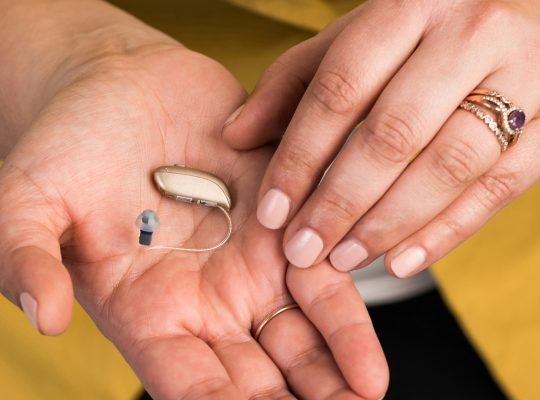There are few places on earth where true silence reigns. Even in the most remote natural areas, you are surrounded by the rustle of leaves, the song of birds, or the sound of wind and water. But in a dead room, also known as an anechoic chamber, you can have an unparalleled experience of absolute silence. These special rooms, designed to completely absorb sounds and exclude external noise, are considered the quietest places on earth.
In this blog, you will discover exactly what a dead room is, how it works, what they are used for and why they are such a fascinating phenomenon. We also discuss what silence does to you and how hearing aids and hearing protection are tested in these unique rooms.
What is a dead room?
A dead room is a purpose-built space in which sound waves are absorbed and not reflected. The word anechoic comes from the Greek word an-echo, which literally means “without echo.” Dead rooms have thick, soundproof walls and an interior lined with sound-absorbing materials such as foam wedges.
The combination of these materials and design ensures that all sounds produced in the room are immediately absorbed. This creates a soundless environment where you won’t hear echoes or ambient sounds.
How does a dead room work?
The design of a dead room aims to minimize sound from both outside and inside. This is achieved by:
- Soundproof walls: Often the walls are several meters thick and made of concrete or steel.
- Sound absorbing panels: The panels, usually wedge-shaped, are designed to trap and attenuate sound waves.
- Suspended floors: The floor floats, as it were, on a spring system to minimize outside vibrations.
Thanks to these techniques, dead rooms often have sound levels below -20 decibels (dB). By comparison, whispers are around 30 dB and the rustling of leaves around 10 dB.
What do you feel in a dead room?
Although the idea of absolute silence sounds appealing, many people find staying in a dead room strange or even unpleasant. Without ambient noise, your attention shifts to your own body. You hear your breathing, the beating of your heart and even the blood rushing through your veins. For some, this can be a meditative experience, while others find it suffocating.
In addition, the lack of reference points can lead to disorientation. Your brain is used to interpreting and placing sounds. In a dead room, this context is missing, which can lead to a sense of loss of balance and even hallucinations.
Applications of dead rooms
Dead rooms have a wide range of uses, from scientific research to commercial purposes.
1. Testing hearing aids and hearing protection
Manufacturers of hearing aids and hearing protection use dead rooms to test their products. Here they can measure exactly how well hearing protection works at muffling sound or how hearing aids amplify different frequencies.
2. Audio tests for technology
Dead rooms are used to test the sound quality of microphones, speakers and other audio products. In a soundless environment, manufacturers can accurately measure how their products perform without noise or interference.
3. Medical examination
These rooms are also used for research on hearing disorders such as tinnitus (ringing in the ears) and hyperacusis (hypersensitivity to sound). By placing patients in a quiet environment, researchers can better understand how these conditions work and how they can be treated.
4. Space
In space, sound is virtually absent, and dead rooms simulate these conditions. They are used to test equipment and prepare astronauts for the extreme silence in space.
Why silence is important
Silence is not only a rarity but also an essential requirement for certain types of research and development. In an increasingly loud world, dead rooms help us understand how sound works and how to better protect our hearing.
Moreover, they are critical to innovations in audio technology. Consider hearing protection with advanced filters, such as earplugs with pressure regulation for air travel or hearing aids that suppress background noise.
Hearing protection and dead rooms
The development of hearing protection requires precision. Dead rooms make it possible to test how well earplugs, earmuffs or other hearing products perform in a controlled environment. This is where manufacturers can verify:
- How much sound is attenuated at different frequencies.
- Whether filters such as flat filters and impact filters work effectively.
- How comfortable the products are in use.
Are there any public dead rooms?
Although most dead rooms are owned by universities, research institutions or companies, there are a few that are open to the public. These locations often offer tours where you can experience the silence for yourself. One of the most famous dead rooms is located at Orfield Laboratories in Minneapolis, United States, and is listed in the Guinness Book of Records as the quietest place in the world.
The Quietest Place in the Netherlands: The Dead Room at TU Delft
In the Netherlands, one of the most advanced dead rooms is located on the campus of Delft University of Technology. This anechoic chamber is used for scientific research on acoustics and sound technology. The chamber is designed to completely exclude external sounds and absorb internal sound waves. This makes it a perfect environment for experiments and tests in the field of sound, such as measuring sound pressure, resonances and the performance of audio technology.
TU Delft’s dead room is also being used to develop new innovations, such as advanced hearing protection products and precision audio technology. The advanced facilities in this room allow researchers to collect accurate data that contribute to practical applications in industry. Visiting this unique room shows how the Netherlands is leading the way in sound research and technology.
TU Delft’s dead room emphasizes the importance of silence as a research tool and shows how scientists and engineers can analyze and exploit sound in all its complexity.
A paradox of silence
The dead room is a place that confronts us with the absence of sound. For some, it offers a moment of introspection, while others find it uncomfortable. Whatever it may be, these spaces help us better understand how sound affects our daily lives.
With increasing noise pollution in our modern world, the role of dead rooms remains crucial. Whether testing new technologies, protecting our hearing or exploring the limits of silence, these special spaces continue to be a source of inspiration and innovation.








